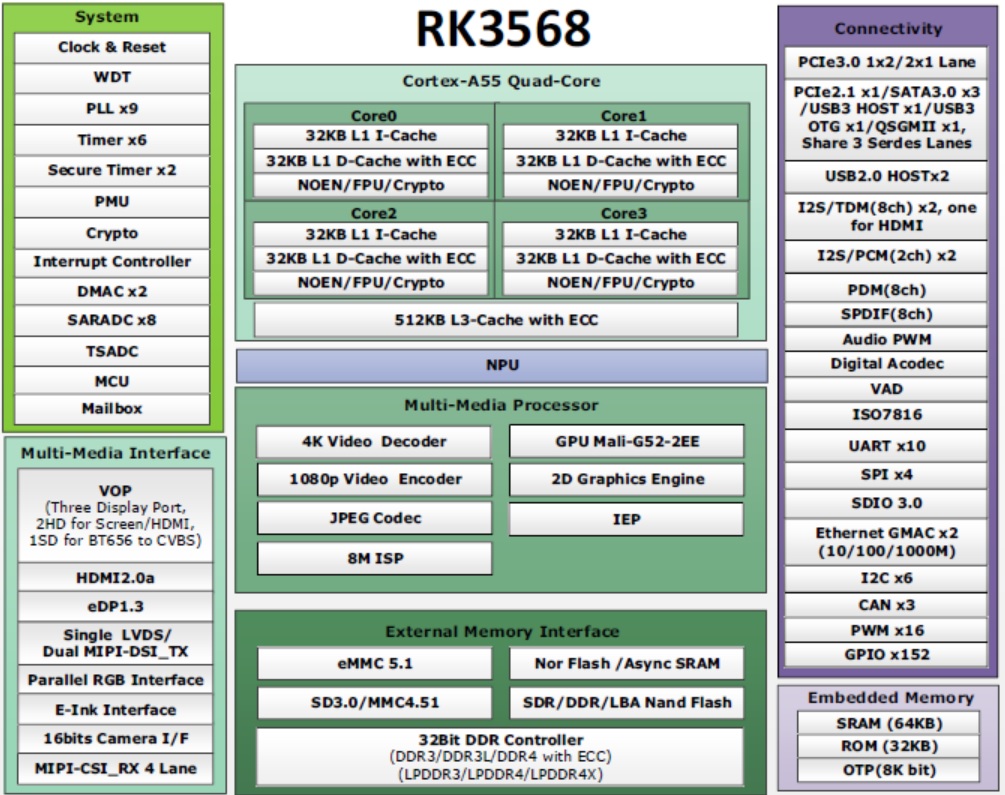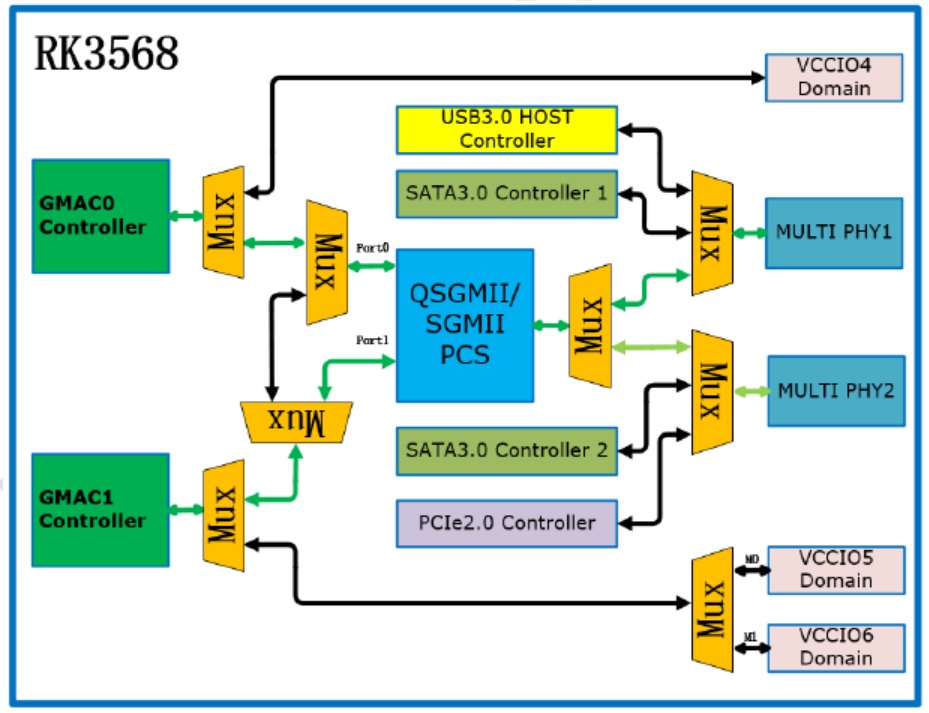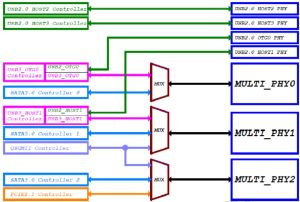Understanding RK3568 Specifications: A Comprehensive Guide
Introduction
This article aims to clarify details not easily discernible from specification sheets and product introductions. For example, which interfaces share multiplexed functions and can’t be used simultaneously, which interfaces are built-in, which features require additional components, and what peripheral components are necessary. This organized information helps product developers quickly understand product specifications, plan product features, and accelerate development time.
Related Products: RK3566/RK3568 >> Check Stock and Price
SOC Block Diagram

CPU, GPU and NPU Specifications
- CPU: Quad-core ARM Cortex-A55, Neon and FPU
- GPU: G52 2EE, supports 3D, OpenGL ES1.1/2.0/3.0/3.1/3.2, Vulkan 1.1, OpenCL 2.0
- NPU: NNIP RKNN, 0.8Tops, INT8, INT16, FP16
- Essential Peripheral Components
- Storage Device (Choose 1 of 5)
- eMMC Interface: Shares pins with FSPI, NAND flash, and 3 other interfaces
- eMMC 5.1 (1/4/8bit): Supports SH200, CMD queue
- NAND flash
- SFC Nor/Nand (SFPI interface)
- SD card SDIO (SDMMC0 200MHz): Shares pins with JTAG
Boot sequence priority: Serial Nor Flash > Serial Nand Flash > Nand Flash > eMMC > SD card
- Power Supply
- PMIC 809-5 or Discrete power supply
- VDD_CPU and VCC_V5_DDR should use dedicated Discrete power supplies
- DDR Memory
- 32-bit DDR, 1600MHz maximum
- Supports LP4/LP4x/LP3/DDR4/DDR3
- LP3/LP4/LP4X supports 4 chip select mode, maximum capacity 8GB
- DDR3 and DDR4 support 2 chip select mode, maximum capacity 8GB
- ECC supports DDR3 and DDR4

Regarding DDR design, RK provides ready-made DDR circuits and layout templates. Customers are strongly advised to use them without modification. DDR circuits mainly use T-type topology structure, but different DDR combinations may use fly-by topology and point-to-point structures. For details, refer to the Rockchip_RK3568_Hardware_Design_Guide_V1.0_CN.pdf.
- Crystal Oscillator
- 24MHz crystal oscillator provides frequency source for RK3568 internal oscillation circuit
- Power amplitude is 8V
- Can switch to 32.768KHz in standby mode to reduce power consumption
- Optional Components (Highly Recommended)
- External RTC chip, as PMIC RK809-5 internal RTC consumes higher power (35-50uA)
- Button battery power won’t last a year
- 32.768KHz Crystal
- For RTC circuit operation
- Supported I/O Interfaces
- Interfaces Requiring Additional Components
- Bluetooth (UART interface)
- WiFi SDIO (SDMMC1 200MHz)
- Camera Interface: CIF/DVP 16bit, IO:150MHz, Supports BT.656/601/1120, Supports VC, Can connect four AHD cameras
- MIPI-CSI: 1×4-lane/2×[email protected]/lane, Can connect two cameras
- Video In: HDMI input functionality through RK628D via MIPI-CSI interface conversion
- ETHERNET x2:
- RGMII x2 (RGMII0/RGMII1) – independent interfaces, not shared with other interfaces like QSGMII, but share MAC0/MAC1 with QSGMII
- Requires PHY to support ETHERNET 10/100/1000
- Maximum support for 2 ETHERNET interfaces
- QSGMII (compatible with SGMII) x1 5Gbps, shares MAC0 and MAC1 with RGMII, so maximum of two ethernet interfaces
- SDIO 3.0 X3 (SDMMC0/1/2)
- Built-in Functions (No Additional Components Required)
Display Output Interfaces
- RGB
- LVDS x1, 24bit RGB/BT1120/BT656
- MIPI DSI x2
- HDMI 2.0b
- eDP for 15.6″ panel
- E-ink
- VOP x3 multi-display: HD x2 + SD x1
USB
- USB 2.0 HOST, OTG (independent interface, not shared like USB3.0)
- USB 3.0 HOST/OTG (USB3 OTG0 is dedicated for flashing images, strongly recommended to keep)
SATA3.0 x3
- SATA supports 1-to-5 Port Multiplier
- Each port can support 5 SATA devices
- Three ports each connected to a Port Multiplier can support 15 SATA devices total
- Supports SATA 1.5/3/6 Gbps speeds
- Supports eSATA
PCIe
- PCIe 3.0, 1×2-Lanes/2×1-Lane@8Gbps (independent interface, not shared like PCIe 2.1)

Audio Interfaces
- I2S controllers x4:
- I2S0/1: each controller supports 8 channels TX and RX
- I2S2/3: each controller supports 2 channels TX and RX
- Bit rate: 16-32 bit
- Sampling frequency: 192KHz
- Master/Slave mode
- Supports standard left and right alignment
- I2S0 is default for HDMI use
- I2S1 supports PCM and TDM, but I2S, PCM, and TDM cannot be used simultaneously
- I2S2 supports PCM, but I2S and PCM cannot be used simultaneously
- I2S3 supports PCM, but I2S and PCM cannot be used simultaneously
- PDM controller x1:
- Supports 8 channels
- Bit rate: 16-32 bit
- Sampling frequency: 192KHz
- Master receive mode
- SPDIF controller x1
Communication Interfaces
- UART x10:
- Transmission rates: 115.2Kbps, 460.8Kbps, 921.6Kbps, 1.5Mbps, 3Mbps, 4Mbps
- Pay attention to power domains and pull-up/pull-down matching when using
- M0/M1/M2 can only be selected one at a time, cannot be used simultaneously
- I2C x6:
- Supports Master mode, 400kbit/s
- Pay attention to power domains and pull-up/pull-down matching when using
- I2C0 is default for PMIC use, please do not modify
- SPI x4:
- In addition to FLASH-used FSPI, there are four SPI interfaces
- Supports both Master and Slave modes
- M0/M1 can only be selected one at a time
- Pay attention to power domains and pull-up/pull-down matching when using
- CAN x3:
- Supports CAN 2.0B, 1Mbps/8Mbps
- M0/M1 can only be selected one at a time
- Pay attention to power domains and pull-up/pull-down matching when using
- PWM x16:
- Four controllers with four channels each
- Total support for 16 channels
- M0/M1 can only be selected one at a time
- Pay attention to power domains and pull-up/pull-down matching when using
- PWM3/7/11/15 channels are optimized for IR
- GPIO x152:
- Three voltage configurations: 3.3V only, 1.8V only, 3.3V + 1.8V
- Adjustable drive strength
- GPIO power domain voltage must match device IO voltage
- Pay attention to DTS voltage configuration to avoid damaging components
- SARADC x8:
- One eight-channel SARADC controller
- Default for key input
- SARADC_VIN0 default for recovery mode boot key, not recommended to modify
- Signal sampling voltage range: 0-1.8V, 10bit
- OTP x1 security application circuit
- TSADC x2 for internal use, for temperature monitoring
III. Major Multiplexed Interfaces
- The Following 4 Interfaces Share 3 SerDes Lanes (Must Choose)

- USB 3.0 HOST/OTG
- SATA3.0 x3
- PCIe 2.1 1×1 lane
- QSGMII
- eMMC Interface Shares with SFPI, NAND Flash, and 3 Other Interfaces
- Ethernet
- QSGMII and RGMII share MAC0 and MAC1, so maximum of two ethernet interfaces
Related Videos
Rock Chip RK3566 AI TV Box Application Product Advantages
RK3566 application in AI smart TV box product advantages introduction, with independent NPU for AI image action, voice recognition, ISP 8M clarity, 8K large screen viewing, and equipped with various high-speed IO interfaces, PCIe, USB3.0.
Rock Chip RK3566 Consumer Product Application Advantages
RK3566 application in consumer electronics product advantages introduction, with independent NPU, security-grade ISP, 4K/60 decoding, 1080P/100 encoding, and equipped with various mainstream IO interfaces, PCIe, USB3.0.